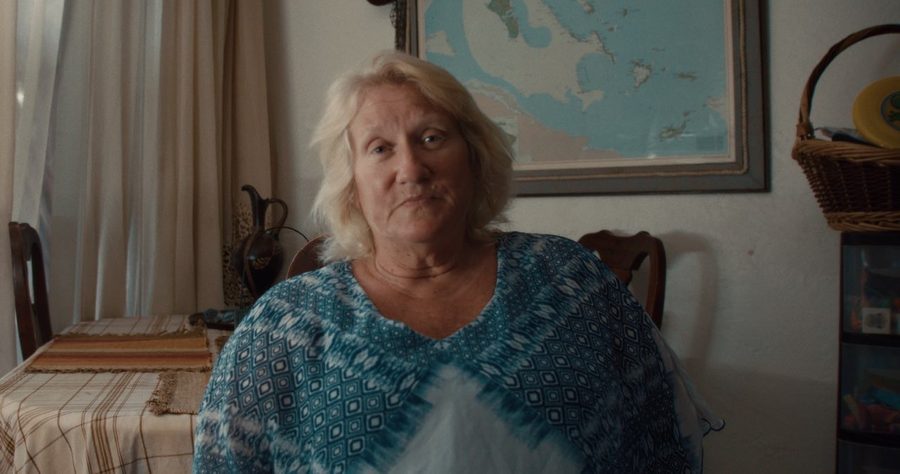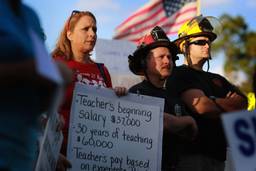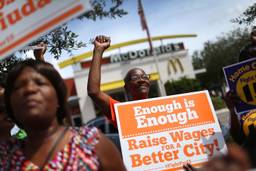What Soaring Rent Prices Mean for Florida's Working Class
One St. Petersburg woman’s struggle to survive the crushing weight of housing inequality.
McKenna Schueler

Bobbie Hill-Ferdinando is a former school bus driver and mother of six who rents a three-bedroom house near St. Petersburg, Fla. She lives with her husband, who is disabled; an adult son, who lives in their garage; an adult daughter; and two grandkids.
The 61-year-old, known by her former coworkers as “Hill,” was born in California and raised in Cincinnati, but St. Petersburg — in the Tampa Bay metro region of central Florida — is home. The family technically lives a few miles from St. Petersburg proper, in South Pasadena, a fifteen-minute drive from the bustling downtown of the Sunshine City. The median home price is $413,000—up 72% from 2021.
In a trend seen across the Sun Belt, Hill-Ferdinando’s monthly rent for her home of 11 years has nearly doubled in recent years, from $995 a month in early 2020 to $1,800 today. Sitting at a wooden kitchen table in their home, Hill-Ferdinando tells In These Times she and her husband got their first rent increase in January 2020 to $1,300 a month, when their former landlord sold their property to his son. Five months later, they saw another $500 increase.
“All about the profit,” Hill-Ferdinando says. “The father never raised the rent,” she adds, shaking her head. “He liked us.”
Over the years, to make ends meet, Hill-Ferdinando has worked as an Uber driver, an Instacart driver and an Amazon packaging driver. The self-described “jack of all trades” has also worked in machinery, auto parts, waitressing and manufacturing. Most recently, Hill-Ferdinando drove a bus for Pinellas County Schools, which serves nearly 100,000 students.
As a bus driver — a union job Hill-Ferdinando held for six years — Hill-Ferdinando made less than $16 an hour. She tells In These Times she’d be scheduled for eight-hour shifts, but would sometimes work up to 16 because of the district’s ongoing driver shortage. “There’s never enough bus drivers,” Hill-Ferdinando says. She worked for the school district as a relief driver — covering any routes the district was short for — which afforded her an extra dollar an hour.
The district offered a $1.50 per hour incentive pay for drivers in 2021, on top of their base pay, and has advertised hiring bonuses. But the $15.69 base pay for the county’s school bus drivers isn’t enough to live on, Hill-Ferdinando says. “All of the bus drivers don’t make enough to live here.” Everyone has a second job, she says — a “side hustle.”
The situation gets even worse during summer break. Drivers can’t collect unemployment, but they also can’t get enough hours to avoid picking up yet another job. “You’re lucky if you get four to six hours in the summer a day, four days a week,” Hill-Ferdinando says. “That’s not enough to live on.”
Hill-Ferdinando left the school district this summer, a decision spurred by frustration with low pay, and an accident on the job that left Hill-Ferdinando feeling like the district didn’t have her back. “You’re running yourself thin” as a bus driver, she says. After several job interviews for positions outside of the public school system, Hill-Ferdinando began work in August as an assembler at a manufacturing company, which offered a starting wage of $20.
One of Hill’s former coworkers, Tangela Butler, has been outspoken about school bus drivers’ wages with the district and local elected officials. Butler says she saw a $500 increase in monthly rent herself, compared with a 50-cent pay raise. At a city budget hearing in May, Butler confronted the city mayor and City Council. “We helped this city, built this city,” she told the council, in reference to the city’s frontline workers and families who have lived in St. Pete for generations. “Our sweat and tears was put into building this city, and we can’t even afford to live here,” she added.
With some local residents reporting 60% to 200% rent spikes, amid an ongoing recovery from unemployment and business closures during the pandemic, families in the city are struggling. Thousands of school children in Pinellas County are homeless, and Butler told city leaders she’d seen this growing problem for herself.
“I’ve been driving for 19 years, faithfully, every morning, getting up all day, picking up the world’s ‘most precious cargo’ as they like to say,” Butler said. But, “These past couple of years,” she added, “I’ve never encountered dropping off as many kids as I have at motels. These children are living in motels,” she said, her voice breaking. “And it breaks my heart to see our kids having to go stay in a motel when they should be in a house.”
About a third of the city’s housing units are occupied by renters, and home ownership is falling. Between 2010 and 2019, Florida added nearly half a million rental units—while losing units renting for less than $1,000.
In St. Petersburg, rent shot up an average 24% in 2021, hitting about $2,200 for a two-bedroom apartment. One 2021 study shows a quarter of homeowners in St. Petersburg — and nearly half of the city’s renters — are “cost-burdened” in terms of housing, spending 30% or more of their income on it.
Wages, on the other hand, aren’t keeping up.
A report from the National Low Income Housing Coalition finds it takes roughly 2.6 minimum wage jobs in the Tampa Bay metro area to cover the average cost of a two-bedroom apartment. Under a ballot initiative passed by Florida voters in 2020, Florida’s minimum wage is currently $10 an hour, although major labor shortages have pushed wages up slightly.
But it’s not just the city’s lowest-paid workers who are struggling to make rent. Many frontline workers — teachers, healthcare workers and even nonprofit workers doing outreach for homeless families — are being pushed out of the city, due to skyrocketing rents and little, if any, financial relief.
Hill-Ferdinando says the situation is unsustainable not just for the city’s working class, who are facing displacement, but the community as a whole. “Without all of us at the bottom, there is no top,” Hill-Ferdinando says. “You don’t have the person that’s going to park your car. You don’t have the person that’s going to serve your meal. You don’t have the school bus driver that’s going to take your kids back and forth to school while you work. You don’t have the daycares that are going to take care of your kids, because we all can’t make it on what they’re paying us.”
Even a $15 minimum wage, Hill-Ferdinando says — which Florida is on track to reach by 2026 — isn’t enough. “You can’t live on $15” in St. Petersburg, she says. “You can’t gas your car, can’t insure your car. You surely can’t rent here for $15 an hour. Not unless you got a cardboard box under a bridge somewhere.
“We’re the backbone of society,” Hill-Ferdinando adds. “There should be a lot of help for people.”
Emergency rental assistance distributed during the pandemic has been insufficient to meet the demand in the city of more than 250,000 residents. Pandemic relief measures, such as the eviction moratoriums — while critically important in mitigating what could have become a massive crisis—did not stop evictions or address the power imbalances between the wealthy and working-class renters that predated the pandemic.
Another factor in the current surge in housing costs is the lack of supply. During the pandemic, the broader Tampa Bay region saw an influx of remote workers with high-paying jobs, without an increase in new housing to match.
For longtime residents, particularly in the city’s historically neglected and majority Black South Side, this influx has been a nightmare. For private investors, however, it’s been an opportunity for big profits. Investor purchases in St. Petersburg grew 79% from 2020 to 2021, and 520% since 2011. The city of St. Petersburg meanwhile, purchased less than two dozen residentially zoned lots in the same 10-year span from 2011 to 2021.
Andrew Ross, a professor of social and cultural analysis at New York University, writes about this takeover in his 2021 book, Sunbelt Blues: The Failure of American Housing. According to Ross, states like Florida that have economies fueled by “an unwholesome cocktail of breakneck growth, hands-off-regulation, depressed wages, and real estate speculation” have been primary targets of Wall Street firms and out-of-town investors “looking to extract rents, fees, and other income streams from every square foot.”
In response to the ongoing crisis, local activists in St. Petersburg have condemned what they see as a prioritization of profit over the people of the city. They’ve called on city leaders — including first-term socialist City Council member Richie Floyd — to take meaningful action to address the problem. “It feels like our city is being handed over to corporations,” Karla Correa, a 22-year-old organizer with the grassroots St. Petersburg Tenants Union, tells In These Times.
Dozens of community members, including frontline workers, activists and faith leaders, have shown up to public meetings, pleading with local elected officials to take bold action.
But activists feel the priorities of city leaders are misplaced. For example, City Council just approved a ballot referendum for the upcoming general election that would deliver a corporate tax break. That referendum, similar to one that failed in 2021, was opposed only by Floyd, a former delegate to the local labor council and former organizer for the local chapter of the Democratic Socialists of America (DSA).
“What [corporations] want is always a priority,” says Correa, who’s helped divert wrongful evictions and organize for stronger tenant protections with the local tenants union. Meanwhile, she says the same urgency isn’t afforded to the “grave housing emergency.”
James Trimarco, a housing advocate and research analyst who organizes with the local Pinellas DSA chapter, tells In These Times his chapter is focusing on what they describe as a long-term solution: the development of city-owned, democratically controlled social housing, where rents would be based on a percentage of tenants’ income.
“Social housing is the cheapest way for cities to create more affordable housing,” Trimarco says.
Although a social housing model has taken off in some parts of the world — in Vienna and Singapore, for example, 50% and 80% of residents live in social housing, respectively — this concept has not been widely utilized in the United States, and certainly not (so far) in Florida, where the concept is antithetical to price gouging.
But the push for expanded public housing and government-financed social housing in the United States is growing. Floyd, the socialist City Council member in St. Pete, is working with Pinellas DSA’s housing working group to develop a social housing proposal. This momentum comes at a time when the city is mulling over ideas for redeveloping the Gas Plant District, a historically Black neighborhood that was razed decades ago to build the Tropicana Field stadium that sits there today.
With support from local activist groups, Floyd has led the way in elected office on pushing for rent stabilization, a guaranteed right to legal counsel for tenants at risk for eviction, and other initiatives addressing the city’s housing crisis.
“I am sick of living in a world where we don’t respect people who need help the most,” Floyd told his colleagues during a discussion on rent stabilization in August. “That’s why I ran for office. I cannot look at people suffering and sleeping on the street, and not want to fight for them and face the ramifications if they come.”
A rent stabilization measure was shot down twice by City Council after being briefly revived by Council Member Deborah Figgs-Sanders in early August. The public policy, meant to provide temporary relief in order to help keep residents housed, has received fierce pushback from the real estate industry, which has contributed to the campaign funds of the mayor — who also opposed a rent stabilization proposal — and all sitting members of City Council, save Floyd. The chair of the city’s housing committee is herself a realtor by trade.
Hill-Ferdinando, the former bus driver, tells In These Times she likes the idea of regulating rents. Rent stabilization is preempted by Florida state law, as it is in most states. But it is possible for municipal governments to enact for one year at a time in Florida if they can identify a “housing emergency so grave as to constitute a serious menace to the general public.” The question of enacting rent stabilization must then go to voters for final approval. In St. Petersburg, that measure has been stalled—for now.
In the meantime, Hill-Ferdinando would also like to see local governments build housing for the public workforce — a supply of affordable housing specifically for those who work for the city or county, such as school bus drivers. “We all make this community,” argues Hill-Ferdinando, whether someone is making $200,000 a year or $20,000.
“It’s not that I want your money,” Hill-Ferdinando says of the higher-income earners that have migrated to the city. “I want to be part of this community. I don’t want to be ousted, and that’s how everybody else feels.”
“This is our home. I deserve to live here as much as you do.”
McKenna Schueler is a staff reporter for Orlando Weekly in Florida, where she covers labor issues, local news and politics. Her work has also appeared in Strikewave, Facing South, Protean Mag and Creative Loafing Tampa Bay.







